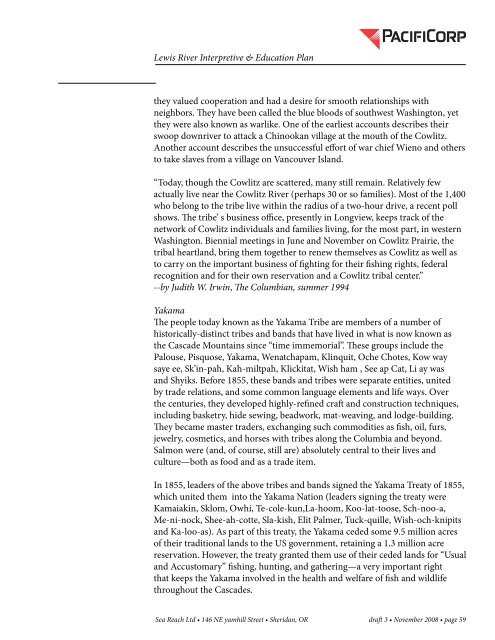The Lewis River Hydroelectric Projects - PacifiCorp
The Lewis River Hydroelectric Projects - PacifiCorp
The Lewis River Hydroelectric Projects - PacifiCorp
Create successful ePaper yourself
Turn your PDF publications into a flip-book with our unique Google optimized e-Paper software.
<strong>Lewis</strong> <strong>River</strong> Interpretive & Education Plan<br />
they valued cooperation and had a desire for smooth relationships with<br />
neighbors. <strong>The</strong>y have been called the blue bloods of southwest Washington, yet<br />
they were also known as warlike. One of the earliest accounts describes their<br />
swoop downriver to attack a Chinookan village at the mouth of the Cowlitz.<br />
Another account describes the unsuccessful effort of war chief Wieno and others<br />
to take slaves from a village on Vancouver Island.<br />
“Today, though the Cowlitz are scattered, many still remain. Relatively few<br />
actually live near the Cowlitz <strong>River</strong> (perhaps 30 or so families). Most of the 1,400<br />
who belong to the tribe live within the radius of a two-hour drive, a recent poll<br />
shows. <strong>The</strong> tribe’ s business office, presently in Longview, keeps track of the<br />
network of Cowlitz individuals and families living, for the most part, in western<br />
Washington. Biennial meetings in June and November on Cowlitz Prairie, the<br />
tribal heartland, bring them together to renew themselves as Cowlitz as well as<br />
to carry on the important business of fighting for their fishing rights, federal<br />
recognition and for their own reservation and a Cowlitz tribal center.”<br />
--by Judith W. Irwin, <strong>The</strong> Columbian, summer 1994<br />
Yakama<br />
<strong>The</strong> people today known as the Yakama Tribe are members of a number of<br />
historically-distinct tribes and bands that have lived in what is now known as<br />
the Cascade Mountains since “time immemorial”. <strong>The</strong>se groups include the<br />
Palouse, Pisquose, Yakama, Wenatchapam, Klinquit, Oche Chotes, Kow way<br />
saye ee, Sk’in-pah, Kah-miltpah, Klickitat, Wish ham , See ap Cat, Li ay was<br />
and Shyiks. Before 1855, these bands and tribes were separate entities, united<br />
by trade relations, and some common language elements and life ways. Over<br />
the centuries, they developed highly-refined craft and construction techniques,<br />
including basketry, hide sewing, beadwork, mat-weaving, and lodge-building.<br />
<strong>The</strong>y became master traders, exchanging such commodities as fish, oil, furs,<br />
jewelry, cosmetics, and horses with tribes along the Columbia and beyond.<br />
Salmon were (and, of course, still are) absolutely central to their lives and<br />
culture—both as food and as a trade item.<br />
In 1855, leaders of the above tribes and bands signed the Yakama Treaty of 1855,<br />
which united them into the Yakama Nation (leaders signing the treaty were<br />
Kamaiakin, Sklom, Owhi, Te-cole-kun,La-hoom, Koo-lat-toose, Sch-noo-a,<br />
Me-ni-nock, Shee-ah-cotte, Sla-kish, Elit Palmer, Tuck-quille, Wish-och-knipits<br />
and Ka-loo-as). As part of this treaty, the Yakama ceded some 9.5 million acres<br />
of their traditional lands to the US government, retaining a 1.3 million acre<br />
reservation. However, the treaty granted them use of their ceded lands for “Usual<br />
and Accustomary” fishing, hunting, and gathering—a very important right<br />
that keeps the Yakama involved in the health and welfare of fish and wildlife<br />
throughout the Cascades.<br />
Sea Reach Ltd • 146 NE yamhill Street • Sheridan, OR draft 3 • November 2008 • page 59
















